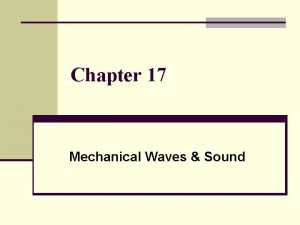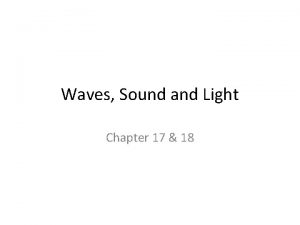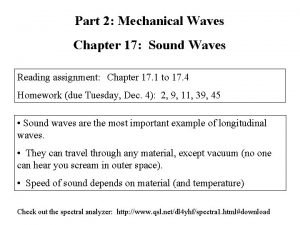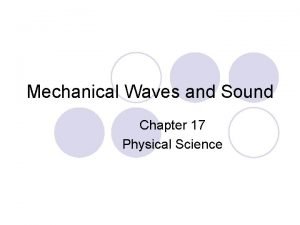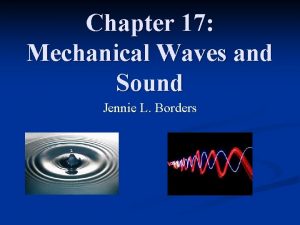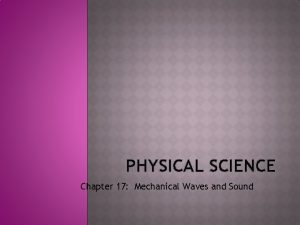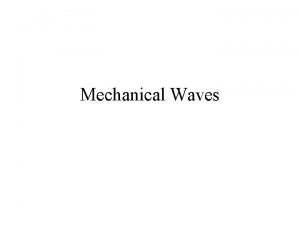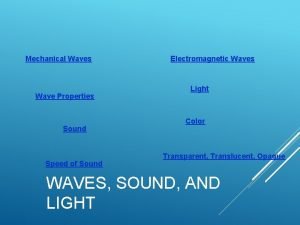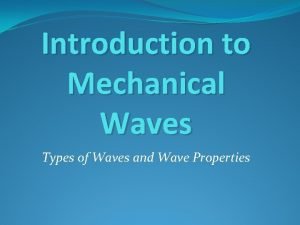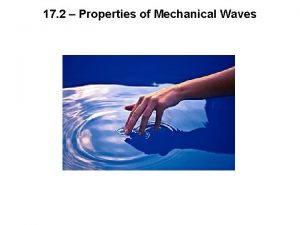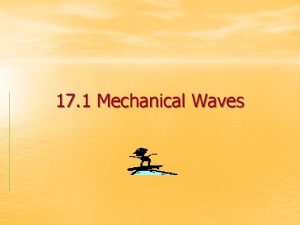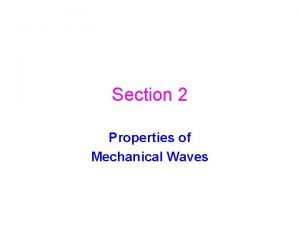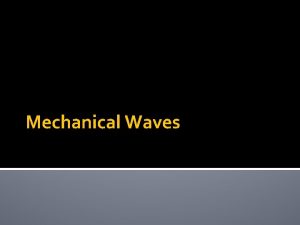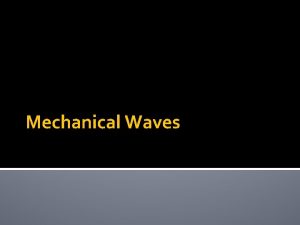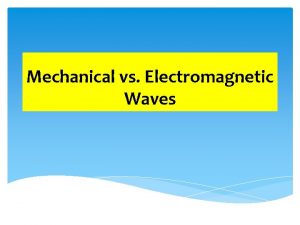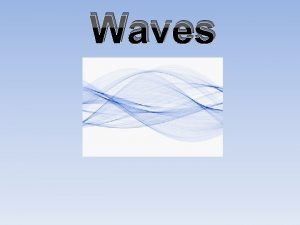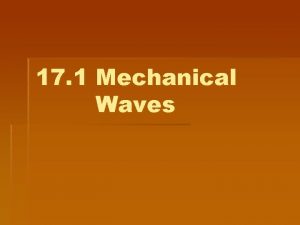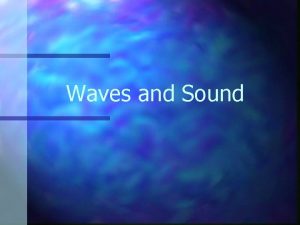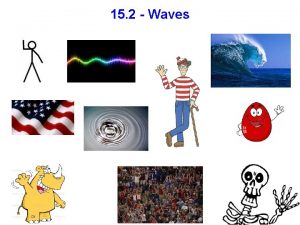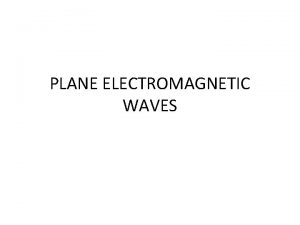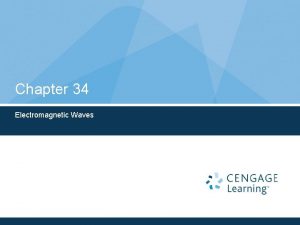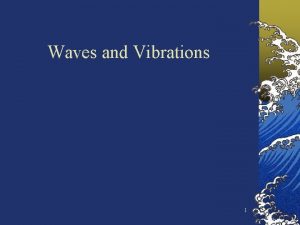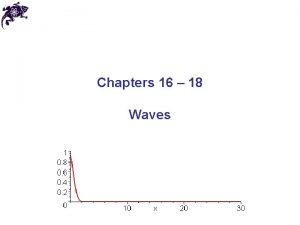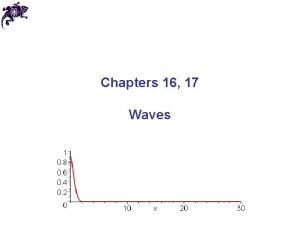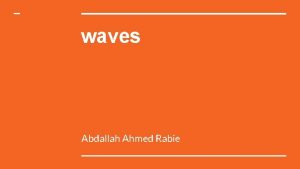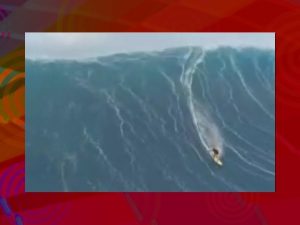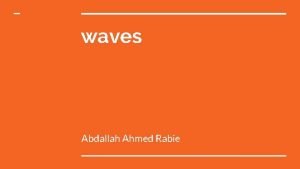Introduction to Mechanical Waves Types of Waves and



























- Slides: 27

Introduction to Mechanical Waves Types of Waves and Wave Properties

Mechanical Waves �What is a mechanical wave? �A mechanical wave is a rhythmic disturbance that allows energy to be transferred through matter because of the motion of and interactions between the particles in the matter �What is the medium? �The medium is the general term for the actual matter through which the wave is traveling. �What is wave propagation ? �Wave propagation is the term given when describing the transfer of energy through a medium

Sketch In Your Journal �It should be at least a ½ page �Leave plenty of room for labeling and definitions

Types of Waves �Transverse Waves: �A wave in which the energy is transferred in a direction perpendicular to the direction of particle movement �This type of wave is typically only found in solids � Example: Earthquake S - Waves, Guitar Strings

Transverse Waves �A wave in which the energy is transferred in a direction perpendicular to the direction of particle movement: Direction of wave propagation Direction of Particle Motion

Transverse Wave Properties Amplitude (A): the maximum displacement of a particle in the medium from its rest position: Direction of wave propagation Direction of Particle motion Amplitude (A)

Transverse Wave Properties Trough: The point in a wave cycle where the medium has reached the maximum displacement BELOW the rest position: Direction of wave propagation Direction of Particle Motion Amplitude (A) Trough

Transverse Wave Properties Crest: The point in a wave cycle where the medium has reached the maximum displacement ABOVE the rest position: Direction of wave propagation Crest Direction of Particle Motion Amplitude (A) Trough

Transverse Wave Properties Wavelength (λ): The distance from one point on a wave to the same point on the next wave (i. e. the distance from crest to crest): Direction of wave propagation Crest Wavelength (λ) Direction of Particle Motion Amplitude (A) Trough

Transverse Wave Properties Direction of wave propagation Wavelength (λ) Direction of Particle Motion Crest Amplitude (A) Trough

Sketch In Your Journal �It should be at least a ¼ page �Leave plenty of room for labeling and definitions

Another Type of Wave �Longitudinal or compression wave: �A wave in which the energy is transferred in a direction parallel to the direction of particle movement �Can be present in solids, liquids, or gases �Example: Sound Waves, Earthquake P-Waves

Longitudinal Waves �A wave in which the energy is transferred in a direction parallel to the direction of particle movement: Direction of wave propagation Direction of Particle Motion

Longitudinal Wave Properties �Compression: The location in the medium of the greatest particle density and highest pressure: Direction of wave propagation Compression Direction of Particle Motion

Longitudinal Wave Properties �Rarefaction: The location in the medium with the lowest particle density and lowest pressure: Direction of wave propagation Compression Direction of Particle Motion Rarefaction

Longitudinal Wave Properties �The wavelength (λ) of a longitudinal wave is typically measured from the beginning of one compression to the beginning of the next (or center to center) Direction of wave propagation Wavelength (λ) Compression Direction of Particle Motion Rarefaction

Longitudinal Wave Properties Direction of wave propagation Wavelength (λ) Compression Direction of Particle Motion Rarefaction

Surface Waves �Surface waves are waves that have characteristics of both transverse and longitudinal waves �Medium particles move both parallel to and perpendicular to wave propagation �Resulting path of particles’ motion is circular �Examples: Water Waves, Earthquakes

Quantitative Wave Characteristics �

Wave Speed �

Wave Speed �

Practice Problem 1 A surfer is waiting for the perfect waves. While waiting, the surfer notices that 7 waves pass by every minute. �What is the period of one of the water waves? �What is the frequency of the wave?

Practice Problem 1 a �

Practice Problem 1 b �

Practice Problem 2 �

Practice Problem 3 �

Mechanical Waves Demo Notes �On the demo note handout: �PREDICT for Demos 1 - 3 �Write down your observations after each demo. �Write a brief summary about the “take home message” for each video demo!
 Lowest point of a wave
Lowest point of a wave Example of mechanical waves
Example of mechanical waves Mechanical and electromagnetic waves similarities
Mechanical and electromagnetic waves similarities Difference between matter waves and electromagnetic waves
Difference between matter waves and electromagnetic waves Mechanical and electromagnetic waves similarities
Mechanical and electromagnetic waves similarities Mechanical and electromagnetic waves
Mechanical and electromagnetic waves Mechanical vs electromagnetic
Mechanical vs electromagnetic Is a seismic wave mechanical or electromagnetic
Is a seismic wave mechanical or electromagnetic Sound waves are electromagnetic waves true or false
Sound waves are electromagnetic waves true or false Types of mechanical waves
Types of mechanical waves Characteristics of mechanical waves
Characteristics of mechanical waves Compare and contrast p waves and s waves using venn diagram
Compare and contrast p waves and s waves using venn diagram Chapter 17 mechanical waves and sound
Chapter 17 mechanical waves and sound Chapter 17 physical science
Chapter 17 physical science Example of mechanical wave
Example of mechanical wave Chapter 17 mechanical waves and sound
Chapter 17 mechanical waves and sound Carbon dioxide temperature
Carbon dioxide temperature Surface waves and body waves
Surface waves and body waves Aimtoknow
Aimtoknow Actual mechanical advantage vs ideal mechanical advantage
Actual mechanical advantage vs ideal mechanical advantage Type of mechanical waves
Type of mechanical waves Parts of a transverse wave
Parts of a transverse wave Example of mechanical wave
Example of mechanical wave Mechanical waves characteristics
Mechanical waves characteristics Properties of mechanical waves
Properties of mechanical waves What do mechanical waves require
What do mechanical waves require Properties of mechanical waves
Properties of mechanical waves Properties of mechanical waves
Properties of mechanical waves









